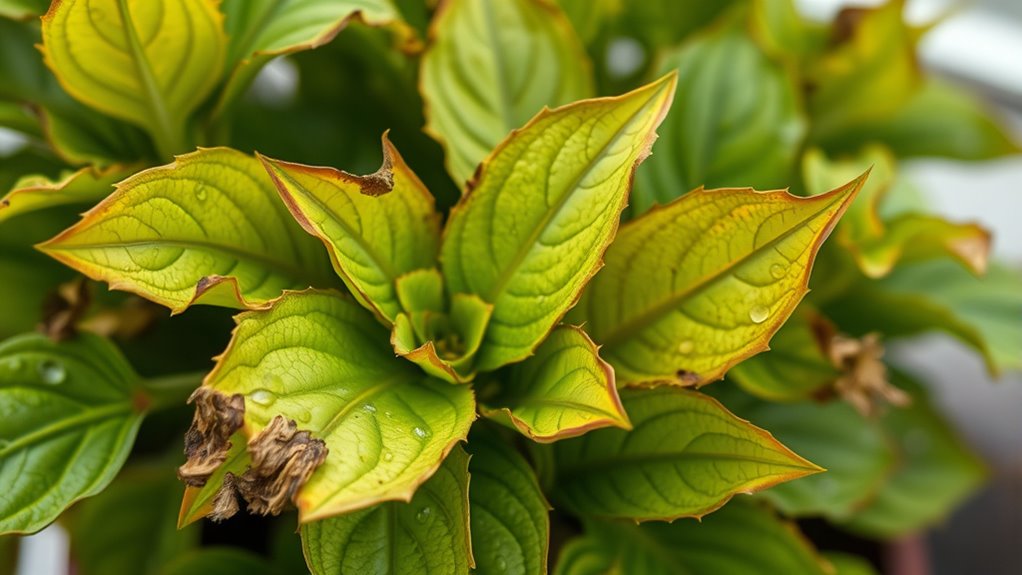To identify common houseplant nutrient deficiencies, look for visual signs like yellowing leaves, especially on older ones, or yellowing between leaf veins indicating iron deficiency. Scorched leaf tips suggest potassium or calcium shortages, while dull, dark green leaves point to phosphorus issues. Monitoring these signs and keeping an eye on soil pH helps you distinguish deficiencies from environmental stress. Stay attentive; understanding these clues can keep your plants thriving and healthy.
Key Takeaways
- Observe leaf color changes: yellowing indicates nitrogen deficiency, while dull green suggests phosphorus shortage.
- Check for interveinal chlorosis on young leaves, signaling iron or manganese deficiencies.
- Look for leaf edges turning yellow or brown with scorched tips, common in potassium deficiency.
- Note deformed, brittle, or swollen growth, which may point to calcium or boron deficiencies.
- Use soil testing and foliar analysis to confirm nutrient imbalances and differentiate from environmental stress.
Recognizing Visual Signs of Nutrient Shortages in Houseplants
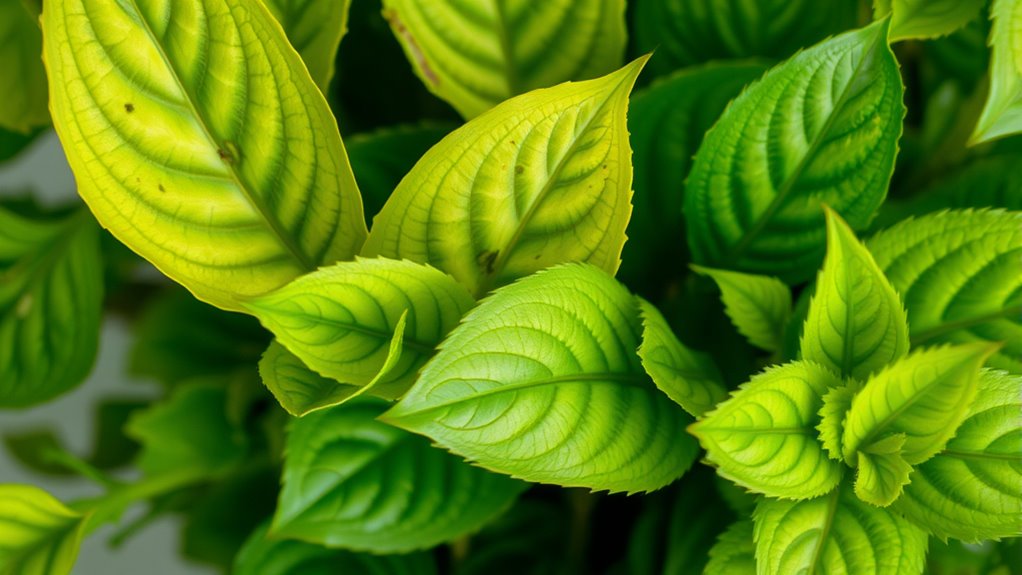
Identifying nutrient deficiencies in houseplants begins with observing their leaves. Yellowing leaves, especially on older or inner leaves, often signal nitrogen deficiency. Look for leaf edges that turn yellow or brown and leaf veins that remain green, indicating specific nutrient issues. A comprehensive understanding of the plant’s overall health can be enhanced by monitoring for visual signs of deficiencies, which provides early warning indicators. Bright yellow edges with scorched tips are typical signs of potassium deficiency, affecting leaf margins. If leaves appear dark green, dull, or blue-green, phosphorus deficiency might be present, often slowing plant growth. Yellowing between leaf veins on young leaves suggests iron deficiency, which hampers chlorophyll production. Deformed, brittle, or swollen growth with dark green, glossy leaves can point to calcium or boron deficiencies. Recognizing these deficiency signs helps you assess your plant’s health and its nutrient uptake, enabling timely corrective action. Additionally, understanding plant nutrient requirements can help prevent deficiencies before they become visible, especially when considering soil testing to determine specific nutrient levels. Being aware of common air purifier technologies can also support a healthier environment that promotes optimal plant growth by reducing airborne pollutants that might stress your plants.
Common Symptoms Associated With Specific Nutrients
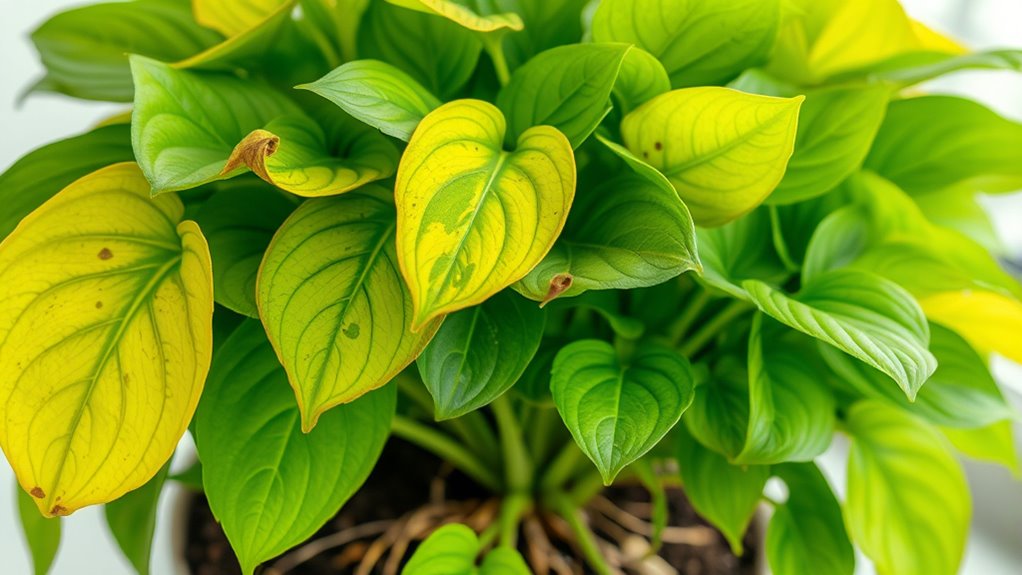
Understanding the specific symptoms your houseplants display can help you pinpoint which nutrients are lacking. Yellowing leaves and leaf discoloration, especially with mottled leaves or necrotic spots, often signal a plant nutrient deficiency.
Interveinal chlorosis, where yellowing occurs between leaf veins, points to iron or manganese deficiency. Efficient nutrient transfer in plants is crucial for maintaining healthy leaf coloration and overall vitality. Proper soil management and fertilization practices can support this process effectively.
Deformed or twisted leaves, along with scorched leaf tips, suggest calcium or boron shortages. Proper soil testing can help determine if these deficiencies are present and guide appropriate supplementation.
Stunted growth and foliar symptoms like dull or dark green foliage can indicate phosphorus deficiency. Ensuring adequate phosphorus levels promotes robust root development and vigorous growth.
Additionally, small, mottled, or necrotic spots on leaves often reveal micronutrient deficiencies such as zinc or copper. Targeted fertilization can correct these deficiencies and restore plant health. Recognizing the role of micronutrients in plant health is essential for comprehensive care.
Understanding how Kia Tuning can enhance vehicle performance is analogous to diagnosing nutrient deficiencies in houseplants, where targeted adjustments lead to improved health and vitality. Recognizing these specific symptoms allows you to target nutrient deficiencies effectively, ensuring your houseplants regain health and vigor.
How to Diagnose Nutrient Deficiencies Accurately
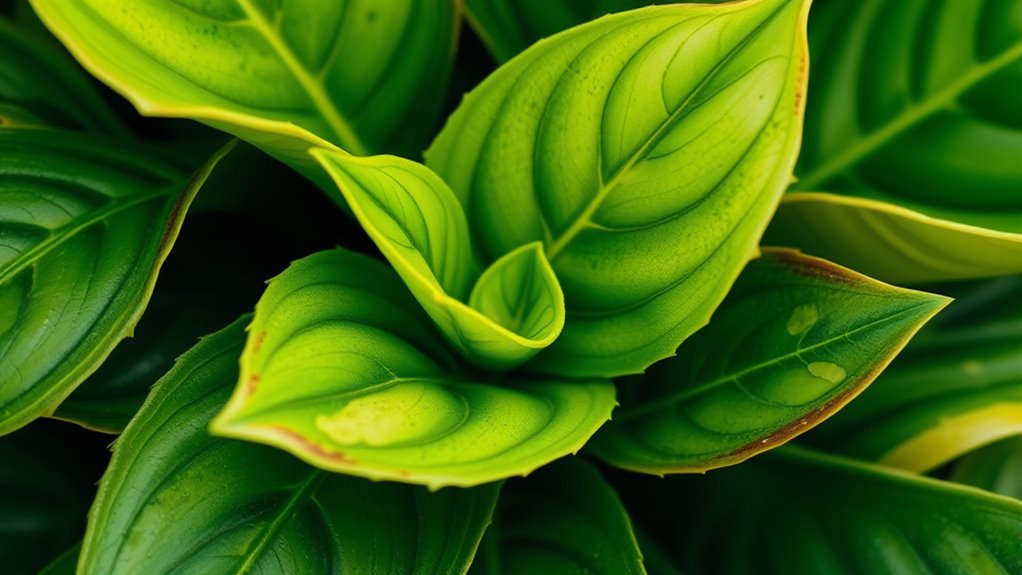
Accurately diagnosing nutrient deficiencies starts with careful observation of your houseplant’s symptoms. Look for leaf discoloration and other visual plant symptoms, which are key diagnostic signs. For example, fine motor skills can influence how well a plant responds to nutrient deficiencies, as healthy growth supports better manipulation of nutrients. Consider these steps:
Careful observation of plant symptoms is essential for accurate nutrient deficiency diagnosis.
- Examine older leaves for yellowing or browning, indicating nitrogen deficiency.
- Check young leaves for yellowing between veins, suggesting iron deficiency.
- Observe leaf edges for scorching or browning, signs of potassium deficiency.
- Use a soil pH meter to test soil or water pH, as imbalances hinder plant nutrient uptake.
- Cross-reference visual symptoms with soil nutrient content and foliar analysis results for deficiency confirmation.
Differentiating Between Deficiencies and Environmental Stress

How can you tell if your houseplant’s symptoms are caused by nutrient deficiencies or environmental stress? Start by observing leaf discoloration, curling, or browning, which can result from both issues.
Environmental stressors like overwatering, drought, or temperature extremes impair nutrient uptake, causing similar symptoms. Check soil pH, as imbalances can prevent plants from absorbing nutrients even if they’re present, mimicking deficiencies.
Additionally, stress from pests, diseases, or physical damage may alter leaf color and texture, complicating diagnosis. To differentiate, monitor environmental conditions closely alongside visual symptoms.
Consistent issues despite proper care may point to nutrient deficiencies, while sudden changes linked to watering or temperature suggest environmental stress. Accurate symptom differentiation helps you address the root cause effectively and maintain healthy plant growth.
Monitoring and Preventing Nutrient Imbalances in Your Plants
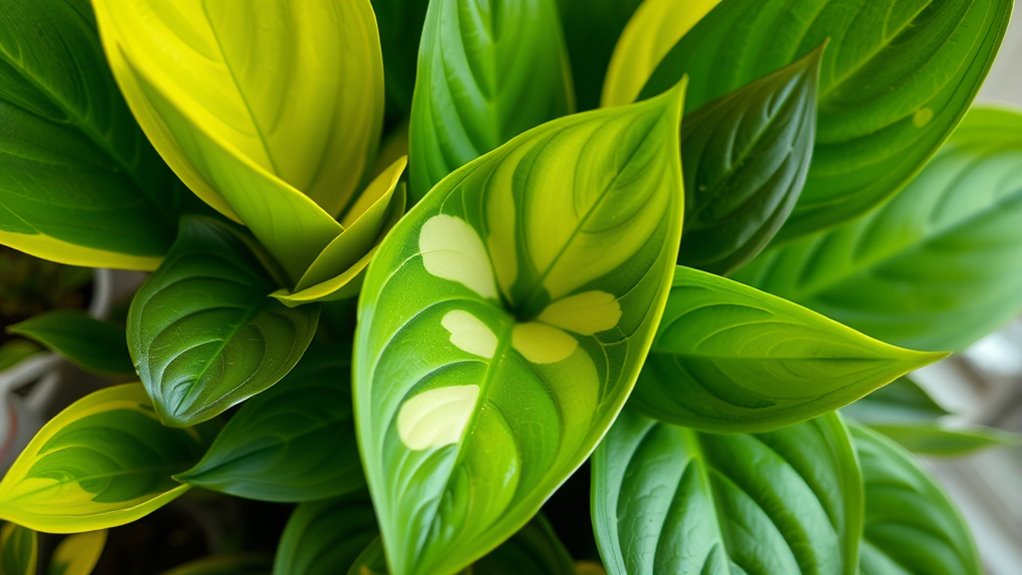
Monitoring and preventing nutrient imbalances starts with regularly testing your soil or water pH and electrical conductivity (EC) levels to guarantee nutrients remain available for your houseplants. This helps you catch issues early before symptoms like poor leaf color or stunted plant growth appear. Additionally, understanding the health and wellness benefits of clean homes can inspire you to maintain a tidy environment that supports overall plant health and reduces potential pest issues. Keep an eye on leaf color, pattern, and overall growth, as these are clues to potential nutrient deficiencies. To maintain nutrient balance, consider these practices:
Regularly test soil pH and EC to prevent nutrient issues before symptoms appear.
- Perform soil testing periodically to adjust fertilization.
- Maintain consistent watering and environmental conditions.
- Use targeted, balanced fertilizers based on specific plant needs.
- Watch for early symptoms to implement corrective measures quickly.
- Keep a nutrient deficiency chart handy for accurate diagnosis and deficiency prevention.
- Regularly monitor soil nutrient levels to ensure your plants receive essential minerals in appropriate amounts. Additionally, understanding how plant nutrient uptake varies with environmental factors can help optimize your fertilization strategies. Being aware of deficiency symptoms enables prompt intervention to restore nutrient balance. Incorporating soil amendment techniques can further improve nutrient availability and overall plant health.
Frequently Asked Questions
Can Nutrient Deficiencies Be Reversible Once Corrected?
Nutrient deficiencies in your houseplants can often be reversed if you catch them early and take quick action. You should correct the deficiencies by adjusting your fertilization routine or using specific supplements.
As long as the damage isn’t too severe, your plants can recover, and their health can improve over time. Regular monitoring and prompt correction are key to helping your houseplants regain their vigor.
Do All Houseplants Show the Same Deficiency Symptoms?
Not all houseplants show the same deficiency symptoms because different species have unique nutrient needs and responses. You might notice yellowing leaves in one plant, while another shows stunted growth or leaf discoloration.
It’s essential to identify your specific plant type and its symptoms to determine the deficiency accurately. Regular observation helps you catch issues early, and adjusting fertilization accordingly can restore your plants’ health effectively.
How Often Should I Test My Soil for Nutrients?
Did you know that testing your soil once a year can boost your houseplants’ health by up to 30%?
You should test your soil for nutrients every 6 to 12 months, especially if you notice yellowing leaves or poor growth. Regular testing helps you catch deficiencies early, ensuring your plants get the right nutrients.
Keep a schedule and adjust your fertilizing routine based on the test results for ideal plant care.
Are There Natural Remedies for Nutrient Deficiencies?
If you’re wondering about natural remedies for nutrient deficiencies, you can try composting your houseplants with organic matter like banana peels or coffee grounds, which add essential nutrients.
Diluted fish emulsion is another option that provides a natural boost. Regularly use these natural supplements, and you’ll help your plants recover without synthetic fertilizers.
Just make sure to apply in moderation to avoid overfeeding your houseplants.
Can Over-Fertilizing Cause Nutrient Imbalances?
Yes, over-fertilizing can cause nutrient imbalances. When you give your houseplants too much fertilizer, it can lead to a buildup of salts in the soil, which prevents roots from absorbing nutrients properly.
This often results in deficiencies of essential nutrients, causing symptoms like yellowing leaves or stunted growth. To avoid this, follow the recommended fertilization schedule, and always water thoroughly after fertilizing to flush out excess salts.
Conclusion
By paying close attention to your houseplants’ signs and understanding their needs, you can prevent nutrient deficiencies before they take hold. Regular monitoring and proper care are key, so don’t wait until it’s too late. Remember, a healthy plant is like a well-tended garden—what you put in determines what you get out. Stay vigilant, nurture your plants, and they’ll thrive, turning your space into a lush, vibrant sanctuary.
